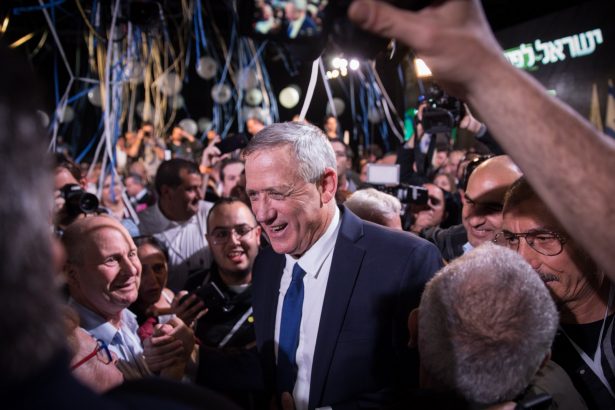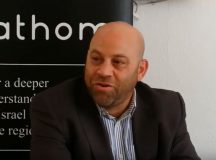Toby Greene argues that the merger between the Israel Resilience Party and Yesh Atid represents the third phase in Israeli centrism, which rather than the Palestinian issue or the economy is focused on the very character of Israeli politics and the values of the state.
The third phase of Israeli centrist politics
The merger of parties led by former IDF chief of staff Benny Gantz and Yesh Atid party leader and former finance minister Yair Lapid, to create the new ‘Blue and White’ party, has created the most credible challenge to Netanyahu from the centre since he was elected in 2009.
But unity comes at the cost of clarity. The new list, that also includes two other former IDF chiefs of staff – former Likud defence minister Moshe ‘Bogie’ Yaalon, and Gabi Ashkenazi – is best characterised as the ABB ‘Anything But Bibi’ party. The formation is not based on a shared policy agenda, and has no common position on the Palestinian question in particular. This may be puzzling for many outside Israel, who might assume this is Israel’s most pressing concern, and the key wedge issue in Israeli politics. Understanding this development requires historical perspective.
What we are witnessing is a third phase in Israeli centrism. The first phase, from around 2005 to 2011 formed around the Palestinian issue. The second phase beginning in 2011 was about the socio-economic grievances of the broadly secular middle class. This third phase is about the very character of Israeli politics and the values of the state.
The Gantz agenda
When Benny Gantz launched his campaign in January, most conspicuous was his attempt to transcend the left-right dichotomy. “There is no more right and left, there is just Israel before all else”, exclaimed his posters and jingles. By way of illustration, his list of candidates includes former Netanyahu aides alongside former Labor candidates.
The central message of his launch speech was not about policy – though it did address policy issues – but rather about the nature of politics and the values of the country’s leadership. “More and more people, both right and left, myself included, are deeply embarrassed by the way our leadership conducts itself,” Gantz declared, “A strong government governs to unite and doesn’t govern in order to separate, to rule.”
When he turned to the Palestinian question – he made a broad commitment to break the deadlock, citing Menachem Begin’s peace with Egypt, Yitzhak Rabin’s peace with Jordan, and Netanyahu’s Bar Ilan speech (in which he accepted the principle of a Palestinian state) as precedents. But he was conspicuously vague on the details.
In a carefully worded passage he said: “if it turns out that there is no way to reach peace at this time, we will shape a new reality. Israel will not be deprived of its status as a strong, Jewish and democratic state … we will maintain security in the entire Land of Israel, but we will not allow the millions of Palestinians living beyond the separation fence to endanger our security and our identity as a Jewish state.”
In the context of Israeli policy debates, this language hints at unilateral steps to separate from the Palestinians in the West Bank, which would preserve the possibility for an eventual two-state outcome. But it does so very obliquely, without even mentioning a Palestinian state. This is because unilateral separation has been explicitly rejected by the right leaning candidates on Gantz’s list (including Moshe Yaalon), and risks alienating a key target constituency: disaffected Likud voters.
Gantz is the latest in a series of candidates to take on Netanyahu and Likud. He is the first however, to mount a credible challenge in terms of the public’s preferred prime ministerial candidate. Gantz has the benefit of being fresh and untainted, whilst dissatisfaction with Netanyahu is growing. In addition, he more closely resembles previous election winners of the centre-left – Yitzhak Rabin and Ehud Barak. They too were former IDF chief of staffs, able to clear the critical threshold of credibility on security, despite signalling pragmatism on the Palestinian question, and offering to reduce tensions between the state and its non-Jewish minorities. It is Gantz’s electoral strength that has enabled him to corral his centre-ground rival Yair Lapid into a partnership, with himself at the head of the ticket.
Gantz though, faces a greater challenge than Rabin or Barak in articulating a coherent program that will win over voters from Netanyahu or his coalition partners. The causes lie deep in the roots of Israel’s social diversity, highly proportional electoral system, and political and social changes over the last three decades.
The roots of Israeli left and right
A combination of high levels of social diversity and a low electoral threshold has resulted in Israel’s party system reinventing itself at every new election.
Israel’s population – even its Jewish population – has always been diverse. At Israel’s founding, it included left-socialist, centrist and right-revisionist parties, as well as religious Zionists, and ultra-Orthodox Jews. With the massive influx of Mizrahi Jews from Middle Eastern countries, their ethnic and socio-economic differences with the Ashkenazi elite also became significant.
At the same time, Israeli party-politics has always been fragmented. As a parliamentary democracy it could be considered Britain’s opposite. Whereas Britain’s first past the post system crushes new parties, by preventing them gaining seats, Israel’s directly proportional system makes it relatively easy for them to gain representation. This reduces the motivation to stay loyal to the large parties, and increases the tendency for splits.
In the early decades of the state, the most coherent block was the Israeli left, representing the dominant Socialist-Zionist ideology of the largely Ashkenazi elites. The bloc were hawkish on security issues, but pragmatic in principle on diplomatic and territorial questions. In the 1970s the Likud formed as a union of right-wing nationalist, territorially maximalist, and economically liberal parties, which managed to also appeal to Mizrahi voters frustrated at the Ashkenazi-dominated elites. It came to power in 1977; partly as a result of a split on the left and the emergence of a short-lived centrist party, ‘Dash’, and formed a coalition with the national religious who shared its commitment to settling in the occupied territories.
Dash soon dissipated, and in the 1980s Israel more closely resembled Britain’s two party system – with Likud and Labor holding well over 40 seats each in the 120 seat Knesset.
Shattering of ideology and first centrist phase
The rise and fall of the Oslo peace process shattered the ideological agendas of both Labor and Likud. Labor pursued a negotiated agreement with the PLO to resolve the Palestinian question. Arafat’s rejection though, of the Barak-Clinton final status proposals in 2000, and the outbreak of the Second Intifada, shattered the credibility of Labor’s gambit that territorial compromise could bring peace. The very term ‘peace’ became a watchword in Israel for dangerous naivety. Fewer and fewer voters identified as ‘left’ – which came to carry similar connotations. The bloody years of the First and Second Intifadas however, increasingly made it apparent that controlling a large Palestinian population – an inevitable consequence of Likud’s territorial maximalism – was also inherently unstable, and threatened Israel’s future as a Jewish and democratic state.
The failure of Likud ideology to cope with this contradiction during the Second Intifada ultimately split the party. Its then-leader Ariel Sharon began a process of unilateral separation from the Palestinians in the Gaza Strip and northern West Bank in 2005, and then led the moderate wing of Likud in the formation of a new centrist party to continue the process in the West Bank.
Their new Kadima party, which included former Labor Prime Minister Shimon Peres, was the first to lead a government from the centre. The agenda to separate from the Palestinians was indistinguishable from that of Labor, with whom it entered a coalition, but it was fronted by Likud defectors – initially Sharon, and later Ehud Olmert and Tzipi Livni.
This centre-left coalition’s term began with the Second Lebanon War in 2006 and ended with Operation Cast Lead in 2009. In both conflicts Israel struggled to prevent thousands of rockets being fired at its towns from formerly occupied territories it had unilaterally evacuated; South Lebanon (in 2000) and the Gaza Strip (in 2005). After Hamas took over the Gaza Strip in 2007, the Olmert government made its own attempt to reach a final status agreement with the PLO, but its best offer was rebuffed.
Faced with these failures, corruption investigations into Prime Minister Olmert, and surging anti-Arab sentiment during Operation Cast Lead, swing voters leaned on right wing parties, and especially Netanyahu’s Likud. With the perceived failure of unilateral disengagement, Kadima’s ‘centrist’ answer to the Palestinian question appeared no more credible than right or left alternatives. Kadima maintained its strength in 2009, but only by taking votes from parties to the left, Labor and Meretz.
The second phase: The marginalisation of the Palestinian issue
For Israeli voters – especially secular-Jewish voters – security is the number one priority. Netanyahu’s success in the 2009, 2013 and 2015 elections (consistently securing around 30 seats) rested on his image as the leader best able to deliver it. After his victory in 2009 he combined this with a diplomatic tack to the centre. Netanyahu offered conditional support for a two state solution, thereby distancing himself from hard-right territorial maximalists, but showed no sense of urgency to bring it about. He engaged in US-sponsored peace negotiations, but the de facto policy was managing the status quo.
The perceived failure of unilateralism, Netanyahu’s theoretical acceptance of a Palestinian state, and the PLO shift away from negotiations towards seeking unilateral recognition, reduced the political salience of the Palestinian question. A majority of the secular-Jewish public agreed: a two state-solution was desirable but unobtainable, since the PLO’s demands exceeded even the most generous Israeli offers, and unilateral withdrawals led to armed Islamist groups on Israel’s borders.
Mass street protests that broke out in 2011 over the cost of living, marked a shift to the second phase of Israeli centrism, with the domestic agenda refocussing on socio-economic issues. This sudden refocusing of the domestic agenda saw Kadima become irrelevant. Its place was taken by Yair Lapid’s new Yesh Atid party, which competed with a shrunken Labor to soak up the socio-economic grievances of middle class families.
Though Lapid also favoured separation from the Palestinians, it was not his banner issue, and he worked hard to reject any attempt to brand him as ‘left’ – the toxic label which had become such a burden for Labor. His principle agenda was promoting ‘equal service’ (meaning conscription) from the ultra-Orthodox sector. This rhetoric captured the frustrations of non-Haredi Israeli-Jewish families. Households with two working parents, with individuals serving in the army and weighed down by the high cost of living, were fed up of subsidising the ultra-Orthodox, whose men were not conscripted and barely worked, through their taxes. This system was sustained by the political power of the ultra-Orthodox, willing to lend Knesset strength to any coalition that fulfilled their demands, and defined by Netanyahu as his ‘natural partners’.
Lapid was significant in recognising the political significance of a demographic shift, whereby due to the rapid growth of ultra-Orthodox, Arab, and national religious sectors, secular Jews found themselves a minority. He appealed not only to the economic interests of this sector, but their values and identity.
The fight for the Israeli centre has become a struggle to win the allegiance of this sector – especially its more affluent (and generally more Ashkenazi) elements – increasingly concerned that the state is being ripped away from them. This sector has proven extremely fluid electorally, seeking a credible candidate to represent it. With the decline of the structural base of the Labor party (old Ashkenazi elites and institutions like the trade unions and the Kibbutzim), and their ideological agenda, the centre-left has until now lacked a stable core party to rival Likud.
In the 2015 election, much of this floating vote coalesced around Zionist Union – a rebranded coalition of Labor led by Isaac Herzog, and a smaller party led by Tzipi Livni. But whilst it looked temporarily like it might overtake Likud, this ticket ultimately failed to win over supporters from the Likud or other right wing parties.
The third phase: Netanyahu and his populism is the issue
As the centrist agenda has evolved, Netanyahu has doubled down on an increasingly populist-nationalist political strategy. His message to the Israeli electorate is that rather than the integrity of the state being threatened by the agendas of the pro-settlement national religious sector, far-right Jewish nationalists, or by ultra-Orthodox parties – his natural coalition partners – it is threatened by a coalition of Arabs, leftists, and liberal elites. These elements would, he claims, erase Israel’s Jewish character, divide Jerusalem, and make territorial compromises that will imperil the country. This was encapsulated in his notorious 2015 election day social media post warning, ‘Arab voters are coming out in droves to the polling stations’, which was credited for a late surge of otherwise apathetic Likud voters, especially Mizrahim in peripheral towns.
Since then, like populist-nationalists in Europe, his coalition has increasingly attacked institutions defending liberal-democratic principles – the media, the Supreme Court, NGOs, critical foreign governments, academics and others – as being part of a conspiracy to undermine the Jewish character of the state. As Netanyahu has become threatened by corruption charges, this assault has extended even to the police and criminal justice systems, who, despite being led by Netanyahu appointees, have been branded as tools of a conspiracy to unseat him.
All these ‘enemies of the state’ are now lumped together and branded with the epithet of ‘smol’ (the Hebrew word for left), which is applied as a term of the greatest denigration. It is combatting this very brand of politics, and the personal corruption of Netanyahu, which has become the new banner issue for parties pitching to the centre in the 2019 election.
Can Gantz lead the centre to victory?
All rivals to the left of Netanyahu understand that to overturn him and his partners, they need to win seats from right wing parties, not just off one another as they have in recent elections. Until this election, the push and pull factors have not been strong enough.
On the one hand, not enough Israeli voters have been sufficiently dissatisfied to abandon Netanyahu, who is still generally regarded as competent with regards to security and the economy. Whilst cost of living is high, the economy is growing consistently and unemployment is low. Israel is in a perpetual security crisis, but the impact has been mainly limited to the Gaza border area and the West Bank settlements. Netanyahu can also tout diplomatic successes, such as Trump moving the US embassy to Jerusalem and pulling out of the Iran deal, in addition to warming ties with India.
On the other hand, opposition parties have not presented a prime ministerial candidate who is sufficiently convincing, especially in the realms of security and diplomacy. Therefore, no opposition leader has had sufficient authority to unite the others in single electoral list, until Gantz.
This explains the three central features of the new Gantz-led centrist constellation: an all-star cast of ex-generals with impeccable security credentials; a commitment to set aside Netanyahu’s populist political agenda; but only the vaguest positions on the Palestinian question.
With indictments for bribery hanging over Netanyahu, this could just be enough to erode Netanyahu’s base and create an anti-Netanyahu Knesset bloc, with the backing of smaller parties including Labor, left-liberal Meretz, and the Arab parties, all committed to preventing Netanyahu forming another government. However, even if such a bloc is able to ensure that Gantz, and not Netanyahu, is asked by President Rivlin to form a government, there is still a plethora of possible coalitions. So aside from a significant change in style, the concrete political program of a future Gantz-led government is difficult to predict. If this new super-party of the centre is forced into opposition, it may not have enough coherence to survive.
Either way, one thing is for sure: with the country’s shifting demographics and deep divisions over the balance between its Jewish and democratic identity, the struggle to define Israel’s future will go on.




































